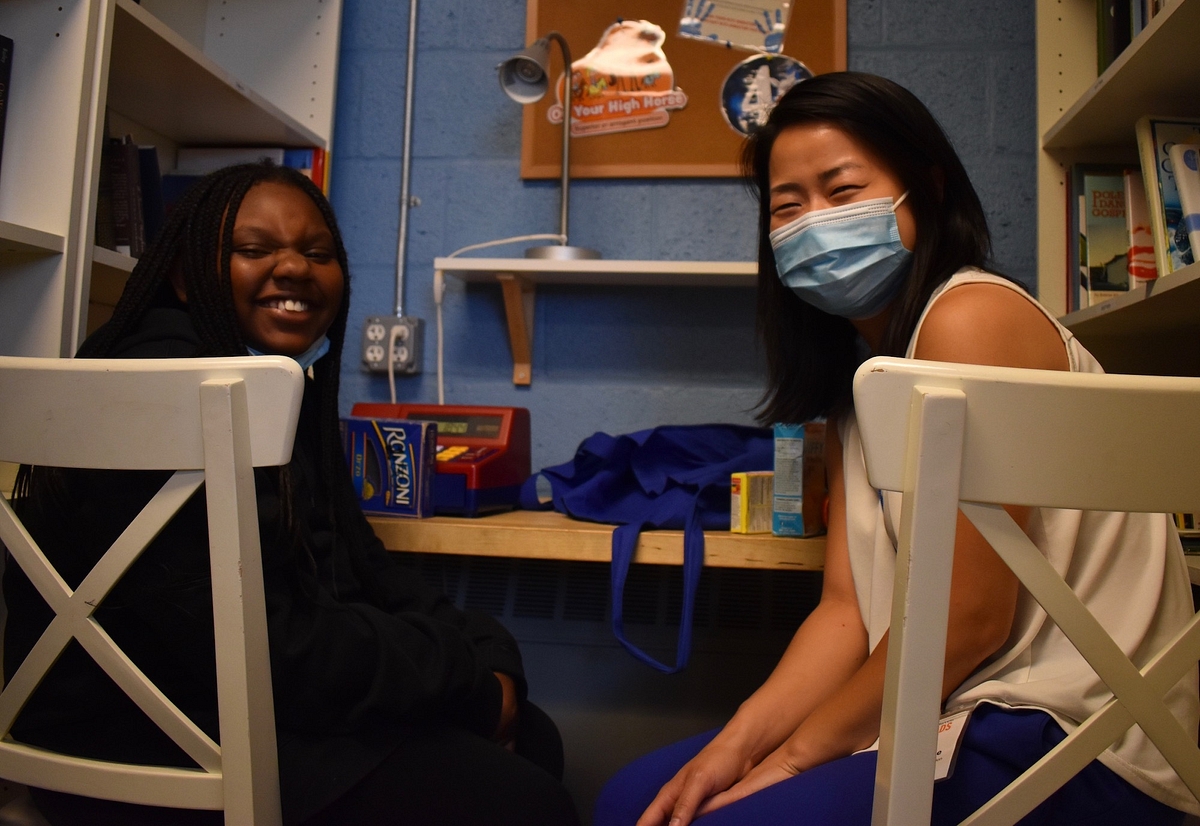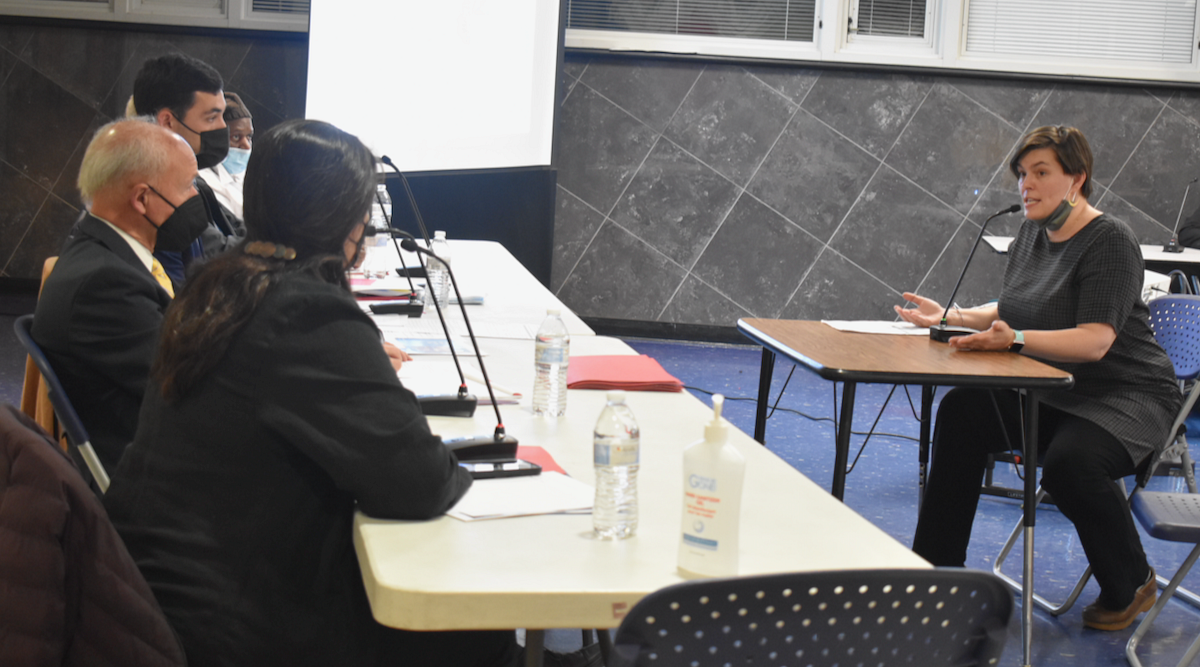
Laura Glesby Photo
Upping her game after school: Serenity Smith with tutor Charlene Cua at New Haven Reads.

NHPS
Newly released numbers show up to 84 percent of third-graders reading below grade level and district-wide numbers that officials called an “emergency” — while disagreeing about who should fix it and how.
Assistant Superintendent for Curriculum, Instruction, and Assessment Ivelise Velazquez presented the board with an early analysis of the district’s English, math, and science assessment data at its regular Monday Zoom meeting.
Velazquez cautioned that the preliminary data won’t show growth metrics and state-wide trend data.
Click here to view the presentation.
District leadership says the primary solution to the academic decline is a need for a village approach to educating students in and outside the classroom. Educators and community members disagreed, arguing that the solution is a funded evidence-based shift in the district’s curricula.
Data from the Smarter Balance state assessment for math and English Language Arts (ELA) showed 3rd through 8th grade results. This year’s assessment, unlike last year’s, was administered only in person.
Of about 8,000 students this year, 23 percent were on grade in ELA, and 12 percent were on grade level in math.
This year’s numbers are lower than those of previous pre-pandemic years like 2019, when 34 percent of students were at grade level for ELA and 22.5 percent for math.
The district’s third-grade students had the highest percentage of students performing below grade level for ELA, with 84 percent of students underperforming for their grade.
The summative data also showed that for grades 3 through 8, more than half of students’ overall performance was below grade level.
The Next Generation Science Standards (NGSS) state assessment tested 5th, 8th, and 11th grade students and was presented alongside pre-pandemic state and district data from 2019. This year’s numbers show a 6.2 percent drop (26.6 percent to 20.4 percent) from the district’s 2019 data.
The results revealed declines in math and reading scores across the board from before the pandemic, with large majorities of students performing below grade level, but with some numbers rising from a year ago and some differences notable from school to school.
In reaction to the presentation, board members Yesenia Rivera, Matt Wilcox, and OrLando Yarborough asked what the districts’s plan is for the future to turn things around.
“This looks really really bad,” Rivera said.
Velazquez said the district is looking to analyze every grade level’s curriculum and provide educators with the “capacity to increase student growth.”
Student representative Dave Cruz Bustamante declared the district’s academic plunge an emergency and crisis.
“Even I in high school, I see a lot of my peers still struggle with reading and writing basic words,” he said.
Velazquez confirmed that the district will be adopting new structured literacy materials to “build the capacity across the early grades.”

2022 K-3 DIBELS data.

Contributed
Student rep Dave Cruz Bustamante: Even high schoolers "struggle with basic words."
The districts also administered the Dynamic Indicators of Basic Early Literacy Skills (DIBELS) test to K‑3 students. The DIBELS test measures students’ reading fluency, processing speed, and phonological awareness.
The district’s DIBELS data showed steady improvements throughout the year; however, more than half of K‑3 students continue to read below grade level.
Kindergarten numbers improved from 14 percent in the fall to 19 percent in the winter to 33 percent reading at benchmark level in the spring. First grade numbers started at 25 percent then increased to 30 percent in the winter and finished the highest of all the grades at 37 percent this spring. Second grade benchmark scores began at 29 percent then 30 percent then finished the year at 33 percent. And third grade scores began at 35 percent declined to 28 percent in the winter and finished at 33 percent in the spring.
Velazquez added that “there’s a lot more data to look at” and reported that the district’s school-by-school breakdown for this years DIBELS assessment has schools with numbers as low as 12.2 percent reading at grade level and some as high as 79 percent at grade level.
“When you look at these averages it’s not flat across the district. There are schools using current curriculum and current materials that again are successful at 79 percent,” Velazquez said. “This year we’ll be looking at that to see what are the different ways that teachers are teaching reading across the districts. We’ll also be taking some very important steps to ensure that teachers know how to teach reading.”
That has been a focus of controversy: Claiming that the old way of teaching doesn’t need to be overhauled, officials including the superintendent and several board members have pushed back against a new state requirement that all schools move from “balanced” to more phonics-based “structured” literacy in the face of new brain research on how kids learn to read.
“Right now we all know that phonics instruction is an area that we want to make sure teachers know how to teach,” Velazquez said. “It’s a tall order, because it’s 28 schools, and it needs to happen, and that’s going to be our number one focus.”
Board Secretary Edward Joyner said teaching students is a community effort. He spoke of eight learning variables that influence student learning that require parents, educators, and the community to educate students rather than “passing the problem on to teachers.” The variables included student readiness and attendance, intervention supports, pedagogical leadership, and adequate material.
“Everybody has a role to play,” Joyner said. “It’s almost like having a chorus. We need to have everybody singing in tune, showing up to rehearsal.”
“In order to lift this heavy load everybody has to participate,” Joyner said. “We’re trying to lay the blame for every social problem at the foot of institutions and we don’t talk about individual and group responsibility.”
Others put the blame on district leadership and approach.
“This data is a five-alarm fire. An expected and entirely preventable one,” said Fair Haven Alder Sarah Miller, a member of the Board of Alders Education Committee. “While districts with similar resources and demographics pivot to more effective teaching methods and see their literacy outcomes begin to improve, NHPS barrels ahead — including in summer school as we speak — with methods that do not meet the learning needs of the majority of our kids.”

2022 High School Common Assessment data.
12% At Grade Level In Math
The high school Common Assessment data shows proficient ELA scores increasing from 26 percent for 9th and 10th graders and 33 percent for 11th and 12th graders to 43.5 percent (9th and 10th) and 58.6 percent (11th and 12th) by the spring. However, Velazquez pointed out a drastic drop in the number of tests administered declining from 2,102 and 1,853 in the fall to 593 and 794 in the spring.
“We need to talk about how assessments, academics are also tied to chronic absenteeism and full implementation curriculum,” Velazquez said.

2022 iReady Math Assessment data.
Locally administered math tests, including iReady and IX,L showed slight improvements for the first full year of implementation of the new programs. The “iReady” program assesses K‑5 students and IXL test 6 – 12th.
iReady saw an improvement from 4 percent of students at grade level in the fall to 20 percent in the spring. That leaves 80 percent of students at least one grade level behind and some three or more levels behind.
Velazquez said the district is considering changing from IXL to a new 6th-12th grade math program to better assess students’ mathematical reasoning.
"This Is An Emergency"
Monday's Board of Ed meeting.
Board member Darnell Goldson agreed with Joyner and said the board, parents, and district leaders all have to take responsibility for the data.
“It’s embarrassing to see where we are in this city with education and I take personal responsibility for being on this board and mpt being able to move the needle,” he said. “And we all should.”
“New Haven Public school system is like a big dead carcass with all these people coming and organizations and people coming to feed on it,” he said. “We have these test, more test, and more test to tell us what the problem is but we don’t have a solution next to that problem.”
Superintendent Iline Tracey said reading comprehension is an important measure that the district wants to do more of with student assessments in the future. She added that the district has students speaking 69 languages, and this too contributes to the difficulty of teaching reading for educators.
Board members and the community requested that central office share its plans and steps in the near future with the board and the community to build trust and offer transparency.
Board member Abie Benitez suggested the district identify how a handful of “master” teachers at some schools have been successful using the district curriculum and have them train newer teachers.
Justin Elicker requested to see the trends of neighboring school districts to understand “how much of it is covid that impacted us versus how much of it is things that we need to be doing differently.”

Maya McFadden Photo
Teacher/parent Sarah Levine testifies at Alder education committee April hearing.
After the Monday meeting, K‑4 reading specialist at Barnard School Sarah Levine weighed the pros and cons of the board’s discussion after the presentation. She described it as a relief that the board “finally acknowledged we’re in an emergency situation” though said she was left feeling frustrated after the presentation because no plan was shared about moving forward.
“It’s worse than I would have expected,” she said. “Today I heard a lot of excuses. I didn’t hear ‘Here’s where we are and here’s our specific plan to move forward.’ ”
Increased parent involvement and community outreach would be great additions to improving the district, she said, but what’s most needed is ample support for teachers to do their job educating students. “Not all parents are accessible, but we can’t blame the kid for that,” she said.
She said the district’s dismal scores over the years, dating back to before the pandemic, have put a pressure on teachers to be accountable for teaching and analyzing data to reform a curriculum that doesn’t work.
“But the board and the central office made excuses. I don’t know why they’re not being held accountable the same way teachers are,” she said. “Teachers are doing what they’re told to do and it’s not working.”
New Haven Reads Tackles "Emergency"

Pushing for change: State Sen. Gary Winfield, at right, at New Haven Reads with Fiona Bradford.
Some New Haven students are receiving literacy instruction both in and out of school, from a combination of the balanced and structured methods.
Leaning over her worksheet in a cozy nook on Friday afternoon, rising fourth grader Serenity Smith brainstormed and sounded out words ending in “ank” with help from her New Haven Reads tutor, Charlene Cua: bank, sank, tank…
While Smith attends East Rock Community Magnet School by day, she spends three days each week during the school year learning through a structured literacy model in New Haven Reads’ afterschool RISE program.
At the Bristol Street reading hub, Smith learns to break words down into combinations of sounds and identify patterns.
“Reading is fun,” Smith said of the New Haven Reads program. “The teachers are nice, kind, and funny.” Her favorite book she’s read so far is Dr. Seuss’ Green Eggs and Ham.
Gov. Ned Lamont and State Sen. Gary Winfield visited the organization’s Bristol Street headquarters on Friday to see the reading programs in action.
New Haven Reads was “a lifeline for our kids who weren’t getting enough from our schools,” said Winfield, a strong proponent of structured literacy. Without a focus on breaking down words into fundamental parts, Winfield argued, “there are going to be a lot of children who don’t know how to read.”
A 2020 – 2021 pilot of the RISE program saw students improve by 40 percent in reading test scores from October to May.






























That the big shots downtown are surprised at the drop shows how out of touch and clueless they all are. NHPS students have hovered around these %'s for years so let's pick the year after a worldwide pandemic to pretend it suddenly is an emergency. Aren't these people even ashamed to look THIS clueless??
Let's test student self-esteem--- that has been inflated and emphasized over competency for years. Should get a good score there!!